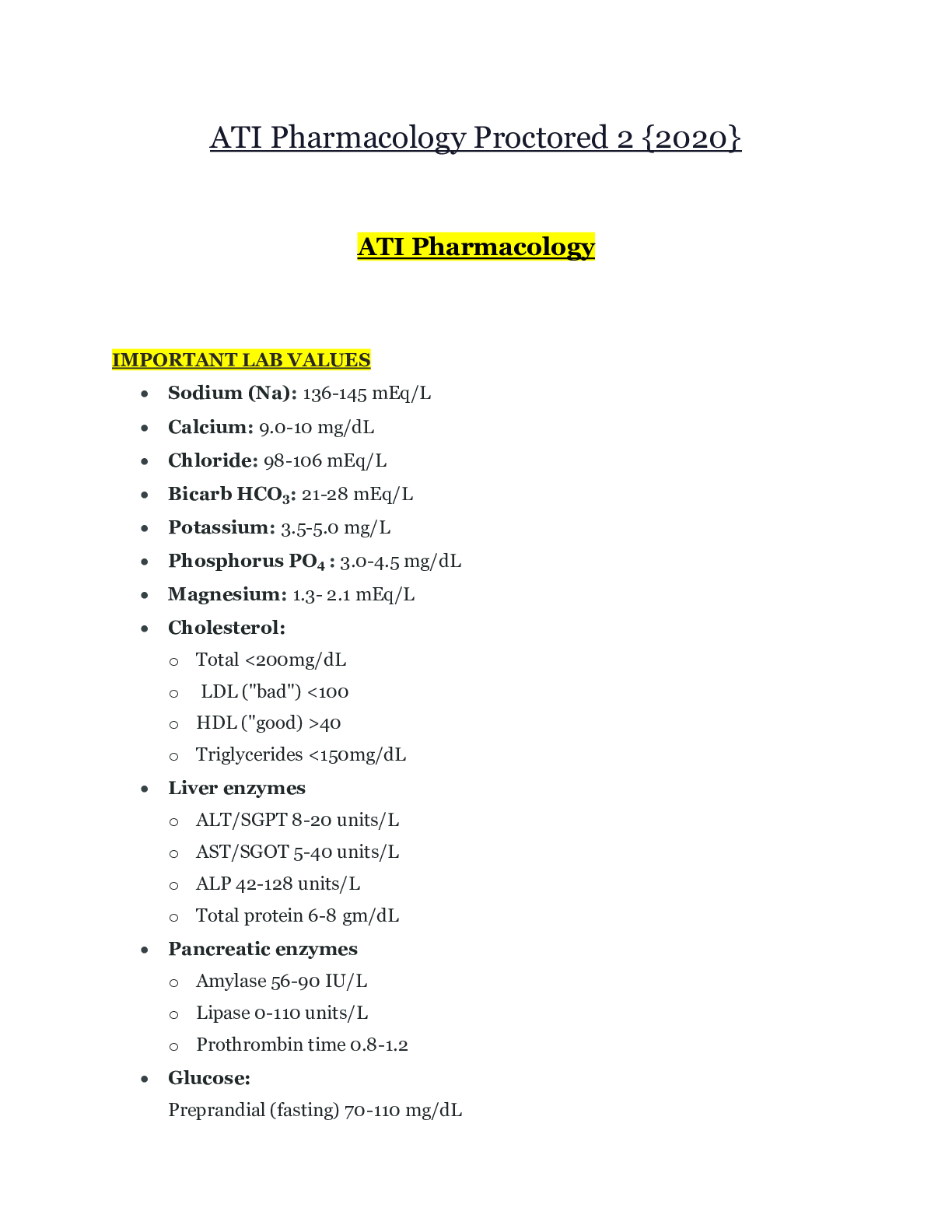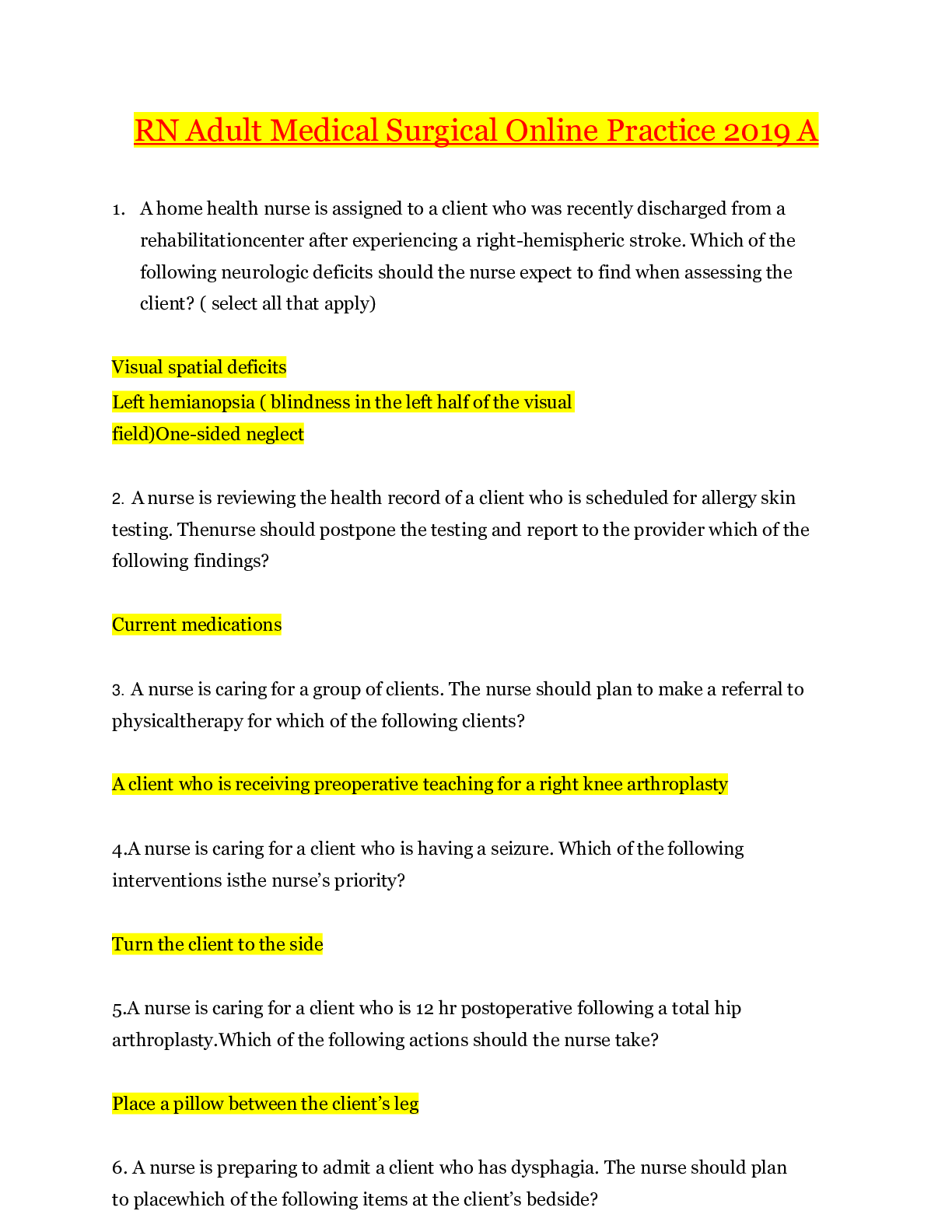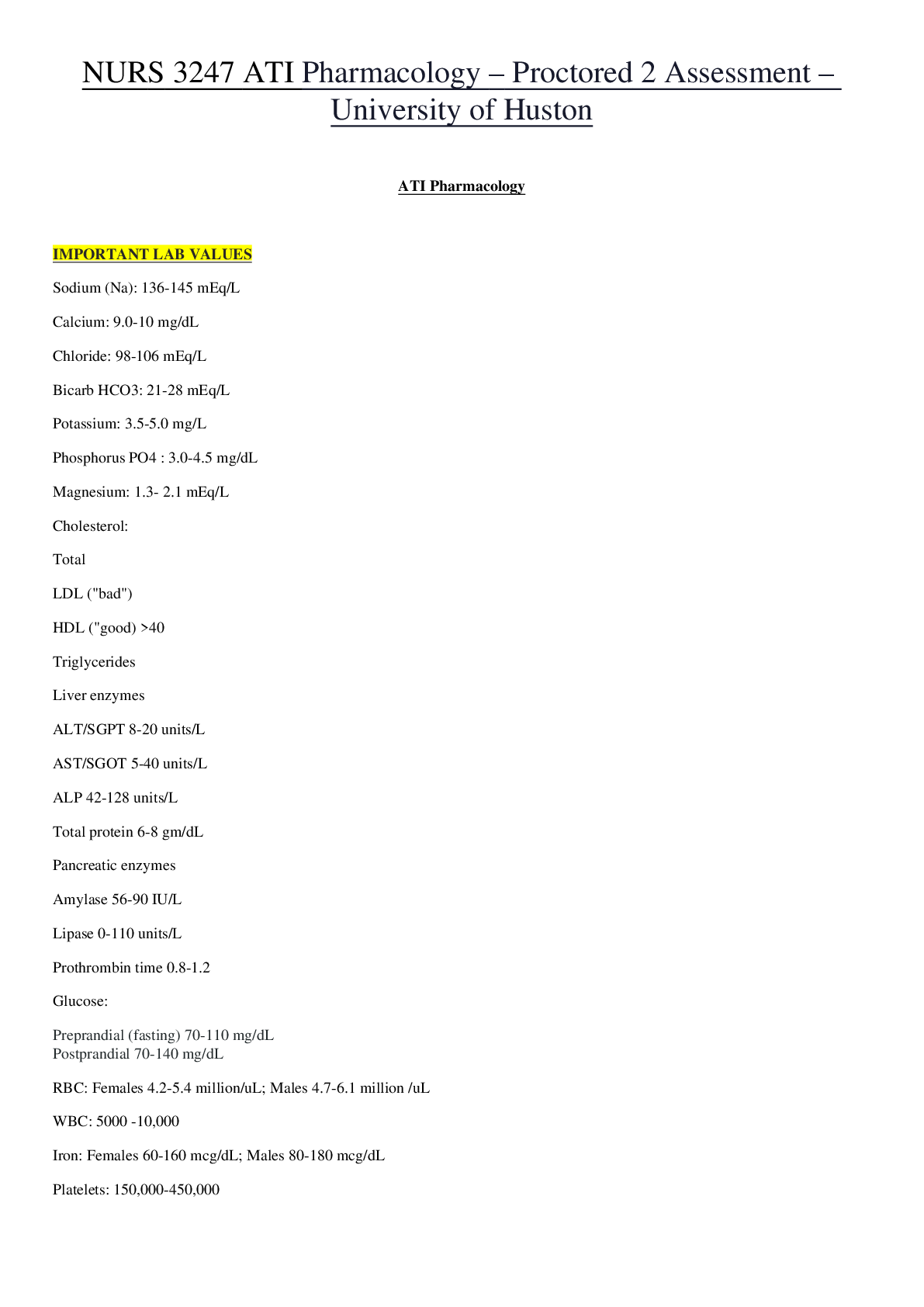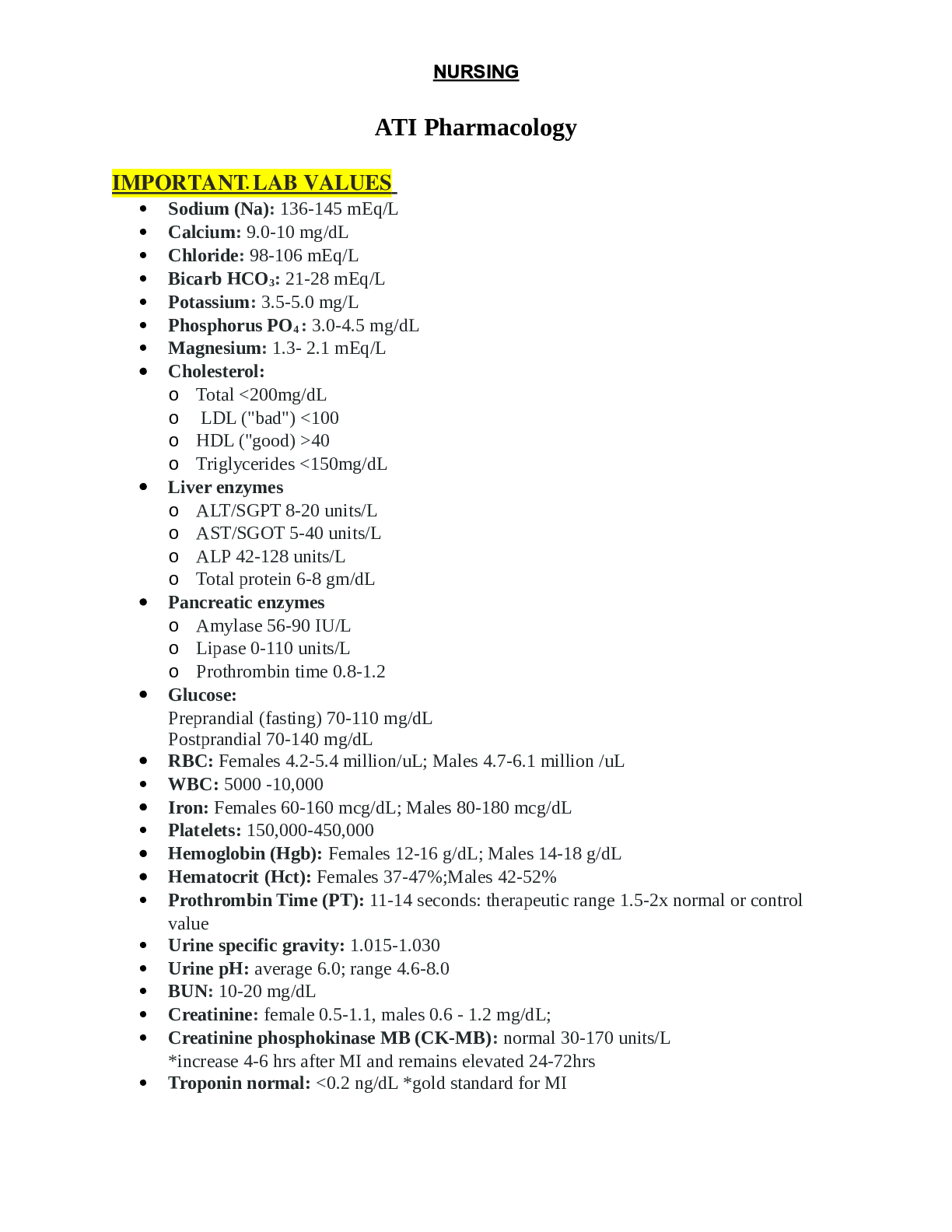Pharmacology > QUESTIONS and ANSWERS > ATI Pharmacology Proctored 2 {2020} | ATI Pharmacology Proctored 2 _ A Grade - School Graded (All)
ATI Pharmacology Proctored 2 {2020} | ATI Pharmacology Proctored 2 _ A Grade - School Graded
Document Content and Description Below
ATI Pharmacology Proctored 2 {2020} ATI Pharmacology IMPORTANT LAB VALUES • Sodium (Na): 136-145 mEq/L • Calcium: 9.0-10 mg/dL • Chloride: 98-106 mEq/L • Bicarb HCO3: 21-28 mEq/L ... • Potassium: 3.5-5.0 mg/L • Phosphorus PO4 : 3.0-4.5 mg/dL • Magnesium: 1.3- 2.1 mEq/L • Cholesterol: o Total <200mg/dL o LDL ("bad") <100 o HDL ("good) >40 o Triglycerides <150mg/dL • Liver enzymes o ALT/SGPT 8-20 units/L o AST/SGOT 5-40 units/L o ALP 42-128 units/L o Total protein 6-8 gm/dL • Pancreatic enzymes o Amylase 56-90 IU/L o Lipase 0-110 units/L o Prothrombin time 0.8-1.2 • Glucose: Preprandial (fasting) 70-110 mg/dL Postprandial 70-140 mg/dL • RBC: Females 4.2-5.4 million/uL; Males 4.7-6.1 million /uL • WBC: 5000 -10,000 • Iron: Females 60-160 mcg/dL; Males 80-180 mcg/dL • Platelets: 150,000-450,000 • Hemoglobin (Hgb): Females 12-16 g/dL; Males 14-18 g/dL • Hematocrit (Hct): Females 37-47%;Males 42-52% • Prothrombin Time (PT): 11-14 seconds: therapeutic range 1.5-2x normal or control value • Urine specific gravity: 1.015-1.030 • Urine pH: average 6.0; range 4.6-8.0 • BUN: 10-20 mg/dL • Creatinine: female 0.5-1.1, males 0.6 - 1.2 mg/dL; • Creatinine phosphokinase MB (CK-MB): normal 30-170 units/L *increase 4-6 hrs after MI and remains elevated 24-72hrs • Troponin normal: <0.2 ng/dL *gold standard for MI - Safe Medication Administration and Error Reduction: Reviewing a Medication Administration Record (RN QSEN - Teamwork and Collaboration, Active Learning Template - Nursing Skill, RM Pharm RN 7.0 Ch. 2) 1) Report all errors, and implement corrective measures immediately 2) Complete an incident report within the time frame the facility specifies, usually 24 hr. 3) Do not reference or include this report in the client's medical record 4) Evaluate clients' responses to medications, and document and report them. 5) Identify side and adverse effects, and document and report them. Chapter 12 - Substance Use Disorders: Therapeutic effect of chlordiazepoxide (Ch. 12 pg.85) - Substance Use Disorders: Smoking cessation using bupropion (Ch. 12 pg. 87) - Substance Use Disorders: Treatment for Cocaine Toxicity (Active Learning Template - System Disorder, RM Pharm RN 7.0 Ch. 12) 1) First line treatment = Benzodiazepines (to reduce CNS & cardiovascular effects) 2) Chlordiazepoxide, diazepam, lorazepam, clorazepate, oxazepam 3) Provide seizure precautions 4) Manifestations include nausea; vomiting; tremors; restlessness and inability to sleep; depressed mood or irritability; increased heart rate, blood pressure, respiratory rate, and temperature; diaphoresis; and tonic‑clonic seizures. Illusions are also common 5) Monitor vitals and neurological status on a regular basis Chapter 13 - Chronic Neurologic Disorders: Adverse effects of neostigmine (Ch. 13 pg. 91) Adverse effects: Excessive muscarinic stimulation Cholinergic crisis - Chronic Neurologic Disorders: Medications that interact with Carbamazepine (Ch. 13 pg. 99) - Carbamazepine causes a decrease in the effects of oral contraceptives and warfarin due to stimulation of hepatic medication-metabolizing enzymes. - Grapefruit juice inhibits metabolism, and thus increases carbamazepine levels. - Phenytoin and phenobarbital decrease effects of carbamazepine. - Chronic Neurologic Disorders: Adverse Effects of Phenytoin (RN QSEN - Safety, Active Learning Template - Medication, RM Pharm RN 7.0 Ch. 13) 1) CNS effects: Nystagmus, sedation, ataxia, double vision, cognitive impairment 2) Gingival hyperplasia: Softening and overgrowth of gum tissue, tenderness, and bleeding gums (consider folic acid supplement) 3) Skin rash (stop medication if rash appears) 4) Cardiovascular effects: dysrhythmias, hypotension (administer slow; 50 mg/min and in dilute solution) 5) Endocrine and other effects: Coarsening of facial features, hirsutism, and interference with vitamin D metabolism (consume enough Vitamin D) 6) Interference with vitamin K‑dependent clotting factors causing bleeding in newborns. - Miscellaneous Central Nervous System Medications: Treating Malignant Hyperthermia (Active Learning Template - Medication, RM Pharm RN 7.0 Ch. 15) 1) Depolarizing neuromuscular blockers: Succinylcholine 2) Manifestations include muscle rigidity accompanied by increased temperature, as high as 43°C (109.4°) 3) Administer oxygen at 100%. 4) Initiate cooling measures including administration of iced 0.9% sodium chloride, applying a cooling blanket, and placing ice bags in groin and other areas 5) Administer dantrolene to decrease metabolic activity of skeletal muscle. - Airflow Disorders: Therapeutic Action of Montelukast (Active Learning Template - Medication, RM Pharm RN 7.0 Ch. 17) 1) Leukotriene modifiers: suppress the effects of leukotrienes, thereby reducing inflammation, bronchoconstriction, airway edema, and mucus production. 2) Long‑term therapy of asthma in adults and children, and to prevent exercise‑induced bronchospasm 3) Depending on therapeutic intent, effectiveness is evidenced by long‑term control of asthma 4) Advise clients to take montelukast once daily at bedtime. 5) For exercise‑induced bronchospasm, take 2 hr. before exercise. Instruct clients taking daily montelukast to not take an additional dose for exercise induced bronchospasm - Upper Respiratory Disorders: Client Teaching Prior to Allergy Testing (Active Learning Template - Medication, RM Pharm RN 7.0 Ch. 18) 1) Medications that can interfere with skin tests include: antihistamines, Tricyclic antidepressants, heartburn medications, asthma medication omalizumab (Xolair) 2) May need to discontinue certain meds 10 days prior 3) If you are running a fever or have an attack of hay fever or asthma, testing should be delayed 4) Do not change your diet before the test. - Medications Affecting Blood Pressure: Titrating Continuous Nitroprusside Infusion (RN QSEN - Safety, Active Learning Template - Medication, RM Pharm RN 7.0 Ch. 20) 1) Nitroprusside (centrally-acting vasodilator) 2) Direct vasodilation of arteries and veins resulting in rapid reduction of blood pressure (decreased preload and after load 3) Used for hypertensive crisis 4) Administer medication slowly because rapid administration will cause blood pressure to go down to rapidly 5) Prepare medication by adding to diluent for IV infusion. 6) Protect IV container and tubing from light & Discard medication after 24 hr. Angina Chapter 22 (pg. 169) Self-administration of nitroglycerine patch (pg. 170) Client teaching for a new prescription of sublingual nitroglycerin - - - -- - - - - - -- - - - - - -- - - - -- - - - - - - - - - - - - - Contraindications/ Precautions: - Imipenem‑cilastatin is a Pregnancy Risk Category C medication. - Use cautiously in clients who have renal impairment. Interactions: - Imipenem‑cilastatin can reduce blood levels of valproic acid. Breakthrough seizures are possible. - Avoid using together. If concurrent use is unavoidable, monitor for increased seizure activity. Nursing Administration: - Advise client to complete the entire course of therapy, even if symptoms resolve. Other inhibitors of cell wall synthesis: - Vancomycin (PO/IV) - Aztreonam, a monobactam, (IM/IV) - Fosfomycin (PO) Adverse Effects: Ototoxicity (rare and reversible) - Assess for indications of hearing loss. - Instruct clients to notify the provider if changes in hearing acuity develop. - Monitor vancomycin levels. Infusion reactions - Monitor for red man syndrome: rashes, flushing, tachycardia, and hypotension.) - Administer vancomycin slowly over 60 min. IM and IV injection‑site pain, thrombophlebitis - Rotate injection sites. - Monitor the infusion site for redness, swelling, and inflammation. Renal toxicity - Monitor I&O and kidney function tests. - Monitor vancomycin trough levels. Contraindications/ Precautions: - An allergy to corn or corn products and previous allergy to vancomycin are contraindications. - Use cautiously for older adults and with clients who have renal impairment or hearing loss. Interactions: - Increased risk for ototoxicity when taking vancomycin concurrently with another medication that causes ototoxicity (loop diuretics, aminoglycoside antibiotics). - Assess for hearing loss. Nursing Administration: - Monitor vancomycin trough levels routinely after blood levels have reached a steady state. - For clients who have renal insufficiency, creatinine clearance levels indicate IV dosage adjustments. Nursing Evaluation of Medication Effectiveness: Indications of effectiveness include the following. - Reduction of manifestations such as fever, pain, inflammation, and adventitious breath sounds - Resolution of infection. - Antibiotics Affecting Protein Synthesis: Dietary Supplement Interactions with Tetracycline (Active Learning Template - Medication, RM Pharm RN 7.0 Ch. 45) 1) Instruct clients to take tetracyclines (except for minocycline) on an empty stomach with 8 oz. water. It may be taken with food if gastric distress occurs. 2) Interaction with milk products, calcium and iron supplements, laxatives containing magnesium, and antacids causes formation of nonabsorbable chelates, thus reducing the absorption of tetracyclines. 3) Tell clients not to take tetracyclines just before lying down because it increases the risk of esophageal ulceration. 4) Instruct clients to maintain a 2‑hr interval between ingestion of chelating agents and tetracyclines. 5) Avoid milk products and antacids, or separate by 2 hr. - Urinary Tract Infections: Evaluating Client Response to an Analgesic (Active Learning Template - Medication, RM Pharm RN 7.0 Ch. 46) 1) Urinary tract analgesic (Phenazopyridine) 2) The medication is an azo dye that functions as a local anesthetic on the mucosa of the urinary tract 3) Relieves manifestations of burning with urination, pain, frequency, and urgency 4) Acute kidney injury and chronic kidney disease are contraindications 5) It changes urine to an orange‑red color (can stain clothing) 6) Instruct clients to take it with or after meals to minimize GI discomfort. [Show More]
Last updated: 2 years ago
Preview 1 out of 32 pages

Buy this document to get the full access instantly
Instant Download Access after purchase
Buy NowInstant download
We Accept:

Reviews( 0 )
$12.50
Can't find what you want? Try our AI powered Search
Document information
Connected school, study & course
About the document
Uploaded On
Feb 06, 2021
Number of pages
32
Written in
Additional information
This document has been written for:
Uploaded
Feb 06, 2021
Downloads
0
Views
211





 – Concorde career College.png)













